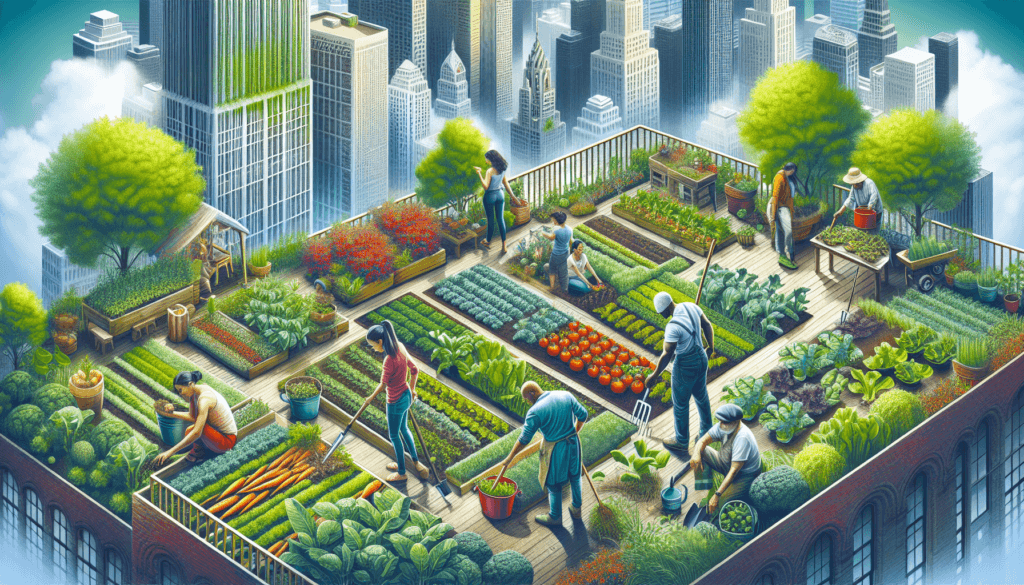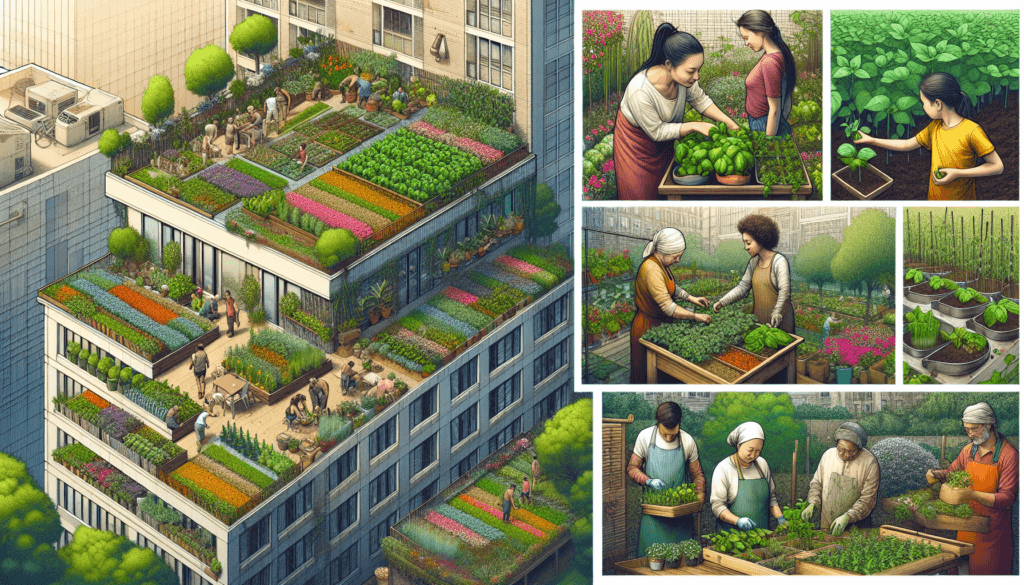Imagine transforming your small urban space into a lush oasis teeming with vibrant, organic produce. Urban Organic Gardening is here to show you how to make the most of your limited space and create a thriving garden in the heart of the city. With our expert tips and tricks, you’ll learn how to cultivate a variety of vegetables, herbs, and fruits right outside your doorstep, all while reducing your carbon footprint and reconnecting with nature. Say goodbye to store-bought produce and hello to the joys of sustainable, homegrown goodness. Get ready to embark on a green adventure that will revolutionize the way you think about gardening.

Benefits of Urban Organic Gardening
Promotes Sustainable Living
Urban organic gardening is a great way to promote sustainable living in urban areas. By growing your own food using organic methods, you reduce your reliance on industrial agriculture and minimize the use of harmful chemicals and pesticides. This promotes a healthier environment and helps protect biodiversity by creating habitats for beneficial insects and pollinators.
Provides Access to Fresh and Healthy Food
One of the major benefits of urban organic gardening is having access to fresh and healthy food right in your own backyard or balcony. By growing your own fruits, vegetables, and herbs, you can ensure that they are free from harmful chemicals and pesticides. Plus, you can harvest them at the peak of freshness, which means they are packed with nutrients and taste much better than store-bought produce.
Improves Mental Well-being
Engaging in urban organic gardening can have a positive impact on your mental well-being. Spending time in nature and nurturing plants can reduce stress and anxiety, and improve overall mood. Gardening can provide a sense of accomplishment and satisfaction as you watch your plants grow and produce food. It also promotes mindfulness and helps you disconnect from the digital world, allowing you to focus on the present moment.
Enhances Urban Biodiversity
Urban organic gardening plays a crucial role in enhancing urban biodiversity. By creating green spaces and cultivating a wide range of plants, you attract beneficial insects, birds, and other wildlife to your garden. These creatures contribute to the overall ecosystem and help maintain a balanced environment. Additionally, urban gardens can serve as stepping stones for migrating species, providing a safe haven in the midst of urban development.
Getting Started with Urban Organic Gardening
Choose the Right Location
When starting an urban organic garden, the first step is to choose the right location. Look for an area that receives at least six to eight hours of sunlight a day, as most plants need this amount of light to grow and thrive. If you don’t have access to a sunny spot, consider using containers or vertical gardening techniques that allow you to position your plants in the sunniest spots available.
Selecting the Right Plants
Selecting the right plants for your urban organic garden is crucial for success. Consider the climate and growing conditions in your area to ensure you choose plants that will thrive. Start with easy-to-grow vegetables like tomatoes, lettuce, and herbs, as they are more forgiving for beginner gardeners. You can also look for dwarf or compact varieties that are specifically bred for small spaces.
Preparing the Soil
Preparing the soil is an important step in urban organic gardening. Start by removing any weeds or grass from the area where you plan to garden. Loosen the soil using a garden fork or tiller to improve drainage and aeration. Incorporate organic matter like compost or well-rotted manure to enrich the soil and provide essential nutrients for your plants. Avoid using synthetic fertilizers or pesticides to maintain the organic integrity of your garden.
Watering and Irrigation
Proper watering and irrigation are key to the success of your urban organic garden. Most plants need about one inch of water per week, either from rainfall or supplemental watering. Consider installing a drip irrigation system to ensure efficient water usage and minimize evaporation. Water your plants deeply and less frequently to encourage deeper root growth and resilience, rather than shallow and frequent watering that can lead to weak plants.

Container Gardening in Urban Areas
Choosing the Right Containers
Container gardening is a perfect solution for urban areas with limited space. When choosing containers for your urban garden, consider materials like clay, plastic, or wood, which are lightweight and durable. Look for pots with drainage holes to prevent waterlogging and ensure proper root growth. Opt for larger containers that can accommodate the root systems of your plants and provide room for growth.
Container Gardening Techniques
There are various techniques and tips for successful container gardening in urban areas. Use a high-quality potting mix that is specifically formulated for container gardening, as it provides proper drainage and nutrient availability. Regularly monitor the moisture levels in your containers and water when the top inch of soil feels dry. Add organic mulch like straw or wood chips to retain moisture and suppress weed growth.
Managing Space in Small Gardens
Space is often a premium in urban areas, but that doesn’t mean you can’t have a productive garden. Make the most of your small garden space by utilizing vertical gardening techniques. Install trellises or stakes to support climbing plants like tomatoes or beans. Hang baskets or use window boxes for trailing plants like strawberries or herbs. Utilize every inch of space by interplanting compatible crops or using companion planting techniques.
Vertical Gardening in Urban Spaces
Benefits of Vertical Gardening
Vertical gardening is an excellent option for urban spaces where horizontal space is limited. It allows you to grow plants vertically, utilizing walls, fences, or structures to maximize your growing area. The benefits of vertical gardening include efficient use of space, better air circulation around plants, and easier access for maintenance and harvesting. Vertical gardening also adds aesthetic appeal to your urban space, creating a lush and beautiful garden.
Choosing the Right Structures
When implementing vertical gardening in urban spaces, choosing the right structures is essential. There are various options available, such as trellises, arbors, and living walls. Consider the weight-bearing capacity of your structures and ensure they are securely anchored. Opt for materials like wood or metal that are weather-resistant and durable. Customize the height and spacing of your structures to accommodate the growth habits of your plants.
Cultivating Climbing Plants
Climbing plants are ideal for vertical gardening as they naturally grow upwards and require minimal space. Some popular climbing plants for vertical gardens include cucumbers, beans, peas, and various types of vine tomatoes. Use twine or plant ties to guide the plants’ growth and attach them to the structures. Regularly check for plant tendrils that need support and gently weave or tie them to the trellises or stakes.

Hydroponics: A Modern Approach to Urban Gardening
Understanding Hydroponics
Hydroponics is a modern approach to urban gardening that involves growing plants without soil. Instead, plants are grown in a nutrient-rich water solution or an inert medium like perlite or coconut coir. The plants receive their nutrients directly through water, allowing for more controlled and efficient nutrient uptake. Hydroponics eliminates the need for soil and reduces the risk of soil-borne diseases and pests.
Setting up a Hydroponic System
Setting up a hydroponic system for your urban garden requires some basic equipment and materials. Start by choosing a suitable hydroponic system, such as nutrient film technique (NFT), deep water culture (DWC), or ebb and flow. Install a water pump, air stone, and nutrient reservoir to provide a continuous flow of nutrient-rich water. Monitor and maintain the water pH and nutrient levels regularly to ensure optimal plant growth.
Choosing Suitable Plants for Hydroponics
Not all plants thrive in hydroponic systems, so it’s important to choose suitable plants for your urban garden. Leafy greens like lettuce, spinach, and kale are commonly grown in hydroponics due to their fast growth and high nutrient requirements. Herbs like basil, mint, and cilantro also perform well in hydroponic environments. Avoid growing plants with extensive root systems or crops that require heavy fruiting, as they may not be suitable for hydroponics.
Managing Pests and Diseases in Urban Gardens
Natural Pest Control Methods
In urban organic gardening, it’s important to manage pests and diseases using natural and environmentally friendly methods. Encourage beneficial insects like ladybugs, lacewings, and bees to your garden by planting flowers that attract them. Use physical barriers like netting or row covers to protect your plants from pests. Employ companion planting techniques by interplanting crops that naturally repel pests, such as marigolds to deter aphids.
Companion Planting
Companion planting is a strategy where certain plants are grown together to benefit each other by repelling pests, attracting beneficial insects, or improving nutrient availability. For example, planting basil or borage near tomatoes can deter tomato hornworms, while planting marigolds near beans can help repel bean beetles. Research companion planting combinations for your specific crop selection to maximize the benefits in your urban garden.
Identifying and Treating Common Garden Diseases
Garden diseases can affect plants in urban gardens, but early identification and treatment can help prevent their spread. Learn to identify common garden diseases like powdery mildew, leaf spot, or damping-off, and take swift action when you notice any symptoms. Practice good hygiene by removing diseased plants or leaves, and avoid overwatering or overcrowding plants, as these conditions can promote disease development. Consider using organic fungicides or biocontrols if necessary.

Community Gardening in Urban Areas
Benefits of Community Gardens
Community gardens are a fantastic way to connect with others in your urban area and promote social cohesion. They provide a shared space where community members can come together to grow food, share knowledge, and build relationships. Community gardens also provide access to fresh and healthy food for those who may not have the resources or space to garden on their own. They enhance the beauty of urban neighborhoods and encourage a sense of pride and ownership.
Organizing a Community Gardening Project
Organizing a community gardening project in your urban area can be a rewarding experience. Start by finding like-minded individuals or organizations who are interested in collaborating. Identify available land or vacant lots that can be transformed into a community garden. Secure permission from the landowner or local authorities and obtain any necessary permits. Establish ground rules and responsibilities, and create a clear plan for garden maintenance and harvest distribution.
Engaging and Educating the Community
Engaging and educating the community is key to the success of a community gardening project. Host regular workshops, gardening classes, or hands-on activities to teach community members about urban organic gardening. Involve local schools or youth organizations to educate the younger generation about the importance of sustainable living and healthy eating. Encourage community participation through events like garden tours, potlucks, or harvest festivals to celebrate the shared success of the community garden.
Urban Gardening Challenges and Solutions
Limited Space
Limited space is one of the biggest challenges in urban gardening. To overcome this challenge, utilize vertical gardening techniques, container gardening, or consider joining a community garden. Maximize your available space by interplanting and using companion planting techniques, and make use of walls or fences for trellises or hanging baskets.
Lack of Sunlight
Many urban areas face the challenge of limited sunlight due to tall buildings or shade from trees. If your garden is in a shady location, choose plants that thrive in low-light conditions like leafy greens or herbs. Consider installing reflective surfaces or using grow lights to supplement natural light. You can also explore nearby areas like rooftops or balconies that receive more sunlight.
Pollution and Contaminants
Urban areas often have higher levels of pollution and contaminants, which can affect plant growth. Test your soil for contaminants and consider growing plants in raised beds or containers with clean soil. Install air filters or use air purifying plants to reduce air pollution. Regularly clean your plants’ leaves to remove dust and pollutants that may accumulate.
Managing Water Usage
Water scarcity is a challenge in many urban areas, so it’s important to manage water usage efficiently. Install rain barrels to collect and store rainwater, which can be used for watering your plants. Consider using a drip irrigation system to minimize water wastage through evaporation. Apply mulch around your plants to retain soil moisture and reduce the need for frequent watering.

Tools and Resources for Urban Organic Gardening
Essential Gardening Tools
To get started with urban organic gardening, there are a few essential tools you’ll need. These include hand tools like a trowel, hand cultivator, and pruning shears for basic gardening tasks. A watering can or hose with a nozzle attachment is essential for watering your plants. Other useful tools include a shovel, a garden fork, a rake, and a wheelbarrow for larger gardening projects.
Online Communities and Forums
Online communities and forums are valuable resources for urban organic gardeners. Joining these communities allows you to connect with experienced gardeners, ask questions, and share your own experiences. You can find valuable advice, tips, and troubleshooting solutions for common gardening problems. Some popular online communities and forums include gardening websites, social media groups, and specialized forums dedicated to organic gardening.
Urban Gardening Apps
In this digital age, there are several mobile apps available that can assist you in urban organic gardening. These apps provide plant care tips, pest and disease identification, weather forecasts, and even personalized planting schedules. Some apps also have community features where you can connect with other gardeners and share your progress. Look for popular gardening apps in your app store and choose the one that suits your needs.
Conclusion
Urban organic gardening offers numerous benefits, from sustainable living and access to fresh food to improved mental well-being and enhanced urban biodiversity. It provides solutions to the challenges of limited space, lack of sunlight, pollution, and water scarcity. Whether you choose container gardening, vertical gardening, hydroponics, or community gardening, there are plenty of options to explore. With the right tools, resources, and knowledge, you can embark on a rewarding gardening journey that brings nature into the heart of the city and nourishes both your body and soul. Start your urban organic garden today and enjoy the many joys and rewards it brings.

